
Stromberg-Carlson, like a lot of companies, made a huge number of radios and their 1936 catalog makes a great example. They took a couple of chassis, made small changes between them, made a variety of different cabinet styles, then mixed-and-matched them to provide a lot of choices for customers. A listing in Radio Today magazine (Sept 1936) has 16 different radios, a mix of consoles, vertical-tabletops, horizontal tabletops, and radio/phono combinations, and I think the listing is incomplete. Anyway, the 130-series chassis appear in five of those, both tabletops and consoles. I have two of them (see my 130-U page).
The 130-series use eight tubes: two 6K7s (RF and IF amps), a 6A8 oscillator/detector, a 6H6 2nd detector and AVC, two 6F6s for audio, and an 80 as the rectifier; the last tube is a 6E5 magic-eye which appeared only on some of the 130s. Stromberg put a socket on the back of the cabinet, so if the actual model included an eye, they'd plug one in. If not, they'd just leave the socket empty.
I got this from an online auction site. They listed it as a Model 228-H but showed a photo of the label, which clearly said it was a 130-J. Photos on the net of 130-Js and 228-Hs look almost identical. The main difference is a tweak in the cabinet: the 130-J's magic eye location is a window directly above the dial, cut in the gutter between two horizontal ribs; the 228-H moved the eye window down onto the face panel. Other than that they look pretty much identical.
Resources
Before I forget again, there's a website that has a good number of service docs on a variety of makes. The website is in Italy but most of it appears to be in English. Their Stromberg-Carlson docs, in particular, appear to be direct from S-C and are a lot better than the Rider versions; at least the ones for the 130-J and 228-H are.
This radio first appears in Radio Retailing magazine, February 1937, described on page 44 in their "preview of new models" section, and also appears in their advertisement on page 2 of the same issue.
This item appears in the Tricks section of Radio Retailing magazine, May 1938, page 53: "Stromberg-Carlson 130, 140. Weak . . . This is common on new sets. The sensitivity control is on the back of the chassis. The purpose of this is to limit local signals, preventing overloads in the RF stage. For increased sensitivity turn the knob clockwise."
Thursday, Feb 5, 2015: Baseline
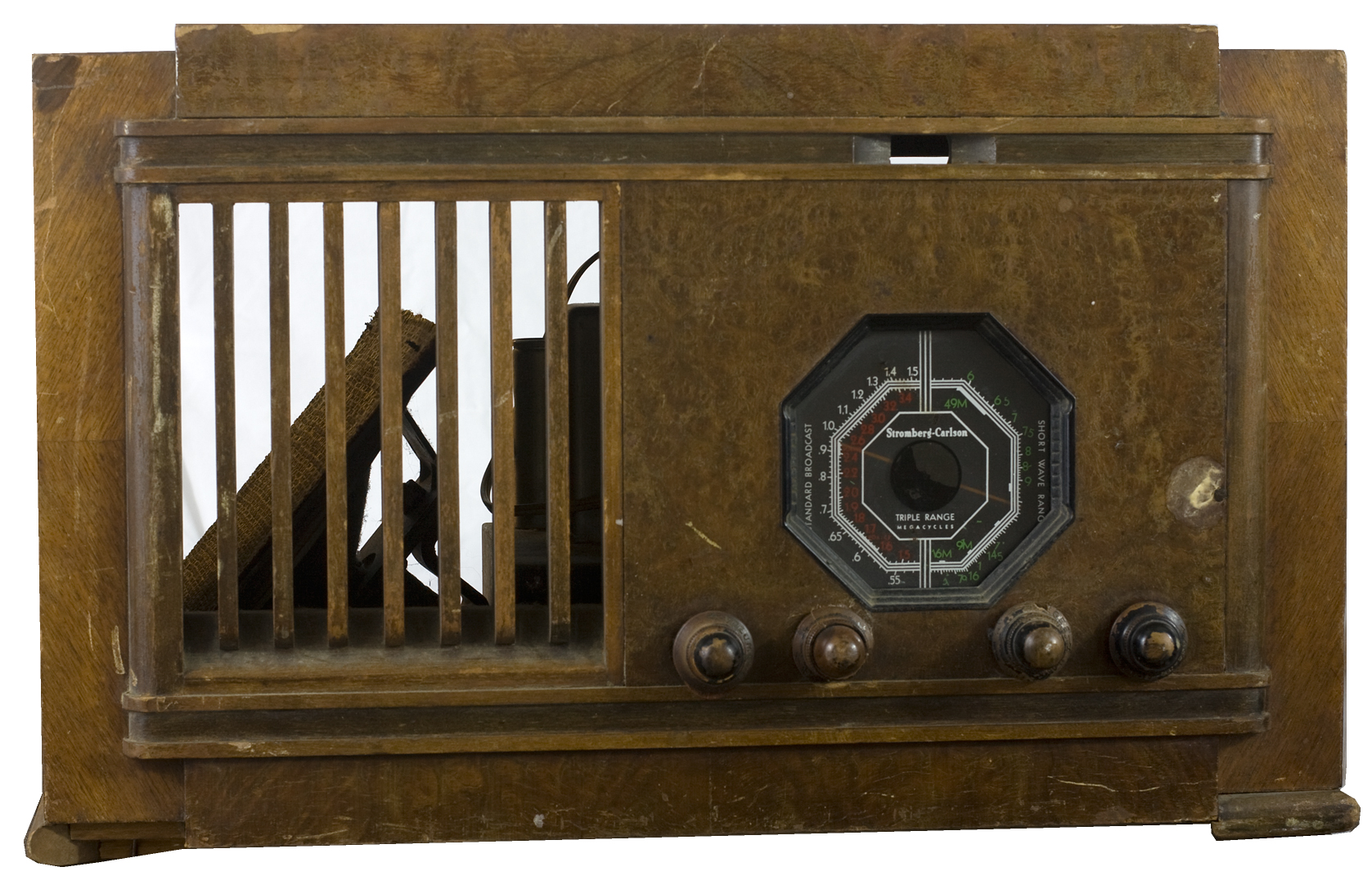 In the original advertising, they called this the "Treasure Box." Right now it looks like a treasure box that was buried by pirates and recently unearthed. The cabinet is pretty rough. There's a big pock mark on the far right facia; there are some gouches and deep scratches here and there. There's a missing piece in the bottom left corner that will have to be replaced. Elsewhere (particularly the top), the veneer is breaking off. I'm not much at wood work so I'm either going to have to learn or farm the work out to someone.
In the original advertising, they called this the "Treasure Box." Right now it looks like a treasure box that was buried by pirates and recently unearthed. The cabinet is pretty rough. There's a big pock mark on the far right facia; there are some gouches and deep scratches here and there. There's a missing piece in the bottom left corner that will have to be replaced. Elsewhere (particularly the top), the veneer is breaking off. I'm not much at wood work so I'm either going to have to learn or farm the work out to someone.
Inside things are looking better. The speaker panel came off but the speaker appears intact and unbroken. I believe the grill cloth is the original and it's relatively clean and in good shape. Just from looking at the back of the chassis, it appears to have all of the tubes except the magic eye, but it does have the eye's socket and wiring, so hopefully all I have to do is plug in an eye. Not sure yet how to mount the eye on the chassis.
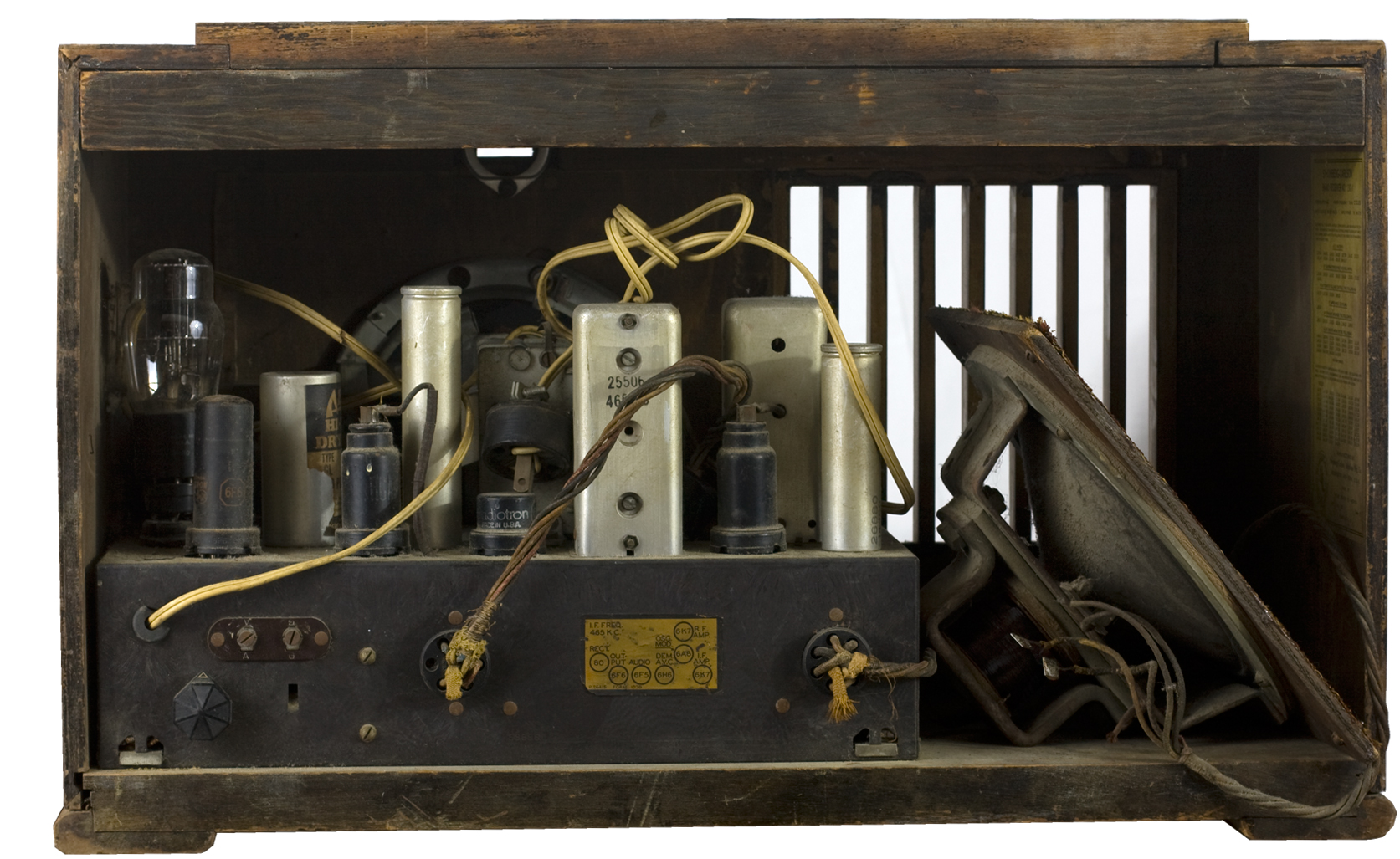 Friday, Feb 6: TIL
Friday, Feb 6: TIL
"TIL" is an internet thing called Today I Learned....
I pulled the chassis out, blew out six inches of accumulated dust, closed the tuning cap, and gave it a quick look over. It appears to be pretty complete and mostly original. I like to test tubes before I do anything, so I began with that.
First one was the glass 80 tube. I thought 80s were pre-octals but not this one. Okay. Didn't really think anything about it, but the filament wouldn't light in the tube tester. The markings on the bakelite base say it's from 1933, so I suppose it could be burned out.
There was no marking on the glass. Despite what I say later, I'm not an idiot: I looked for the marking before I attempted to clean it because I know how easy it is to wipe some of them off. It's lone gone. But it's an 80, and it's burned out.
Later one I was looking at the chassis and noticed the socket was odd. At first I thought someone had stuck a socket-saver in it; then I thought the original socket was probably broken and someone stuck another on top of it as a quick and dirty fix. Finally realized it was an octal-to-4-prong adapter. That's not an 80...
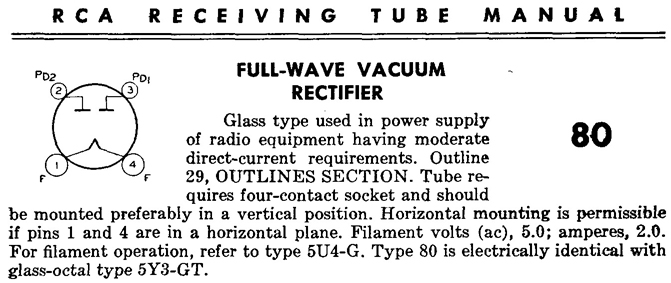
It's a damned 5Y3! I have one in stock, so I pulled and compared. It's the same tube. So re-set the Hickok for a 5Y3 and it tested strong. Amazing what happens when you get the machine set right.
So TIL the difference between an 80 and a 5Y3. And I should have known this because my Philco Baby Grand has an 80 in it, and it's all pre-octal.
More embarassing was testing the other tubes, which were all metal octals with nice white markings that don't rub off when you spritz them with Windex to clean the top layer of crud off them. Unfortunately, they fail the shorts tests when you do that. The first one failed and I thought okay, that happens. The the next one failed and I got suspicious because I rarely come across tubes that fail shorts tests. The third tube I didn't clean first, just stuck it in the tester and it tested fine. Cleaned it, put it back and short! It's not like I was bathing these things, and I wasn't even cleaning the base, but I suppose it was enough. It's a nice warm day so I let them air dry and tried them again later in the afternoon; all good.
That means I'm only missing the eye tube, and it'll be awhile before I'll be ready for that anyway. I thought I'd try a new source, the National Capital Radio & TV Museum's tube store. They have excellent prices and they're not trying to sell me hideously overpriced matched pairs of audiophile tubes made in former Soviet-bloc countries. It'll be awhile before I get it, so I canl work on other things without being held back.
Saturday, Feb 7: Let's Find Out What's Wrong
For the cabinet, because I know even less about woodworking than I do about electronics, I put some Old English scratch cover on it, and the cabinet looks better. It's still battered and beaten and has a lot of scars, but it looks better.
On the chassis, I replaced all the tubes except the rectifier, plugged the chassis into the isolation transformer and fired it off. No smoke, no sparks, no crackles or pops. Turned it off, looked it over, and decided to try again with the rectifier. Everything lit, including the two dial lamps. I plugged in the speaker and from the crackle on the volume pot, it's obvious the audio section is alive, but no radio.
Some futzing around, thought only half-jokingly of poking around with a butter knife, and decided to see if I could at least figure out what band I'm on (there are three). The knob I pulled off only says "bands" and I did not see an indicator on the dial. So I strengthened my fingers trying to crank the tuner open (it works hard) a bit, and between the three switch positions and slowly sweeping with the signal generator, I was able to pick up a signal, and loud. Then I could hear it zero-beating something, so I disconnected the generator, opened up a whip antenna and pressed the end against the antenna jack on the chassis, and adjusted the tuner until I could pick up 640 kHz, KFI in Los Angeles.
As KFI is one of the few stations I get that's strong, picking it up gives me a few ideas of where things are with the radio; the fact that I got it at all means the RF section obviously works; that it's loud and means the RF and the AF are both working (as opposed to my recent experiences with the Packard Bell and the RCA 56X, where strong stations were just eeking in). So!
No hum. The controls are noisy as hell. And I'm not sure what I can to loosen up the tuner a little, but man, the fact that this works means (hopefully) the rest of it won't be an ordeal.
Monday, Feb 9: Knobs
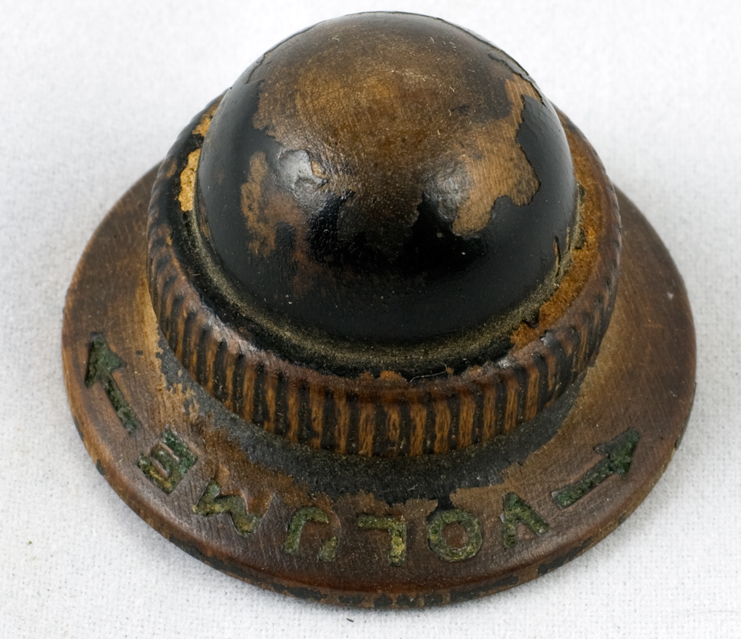
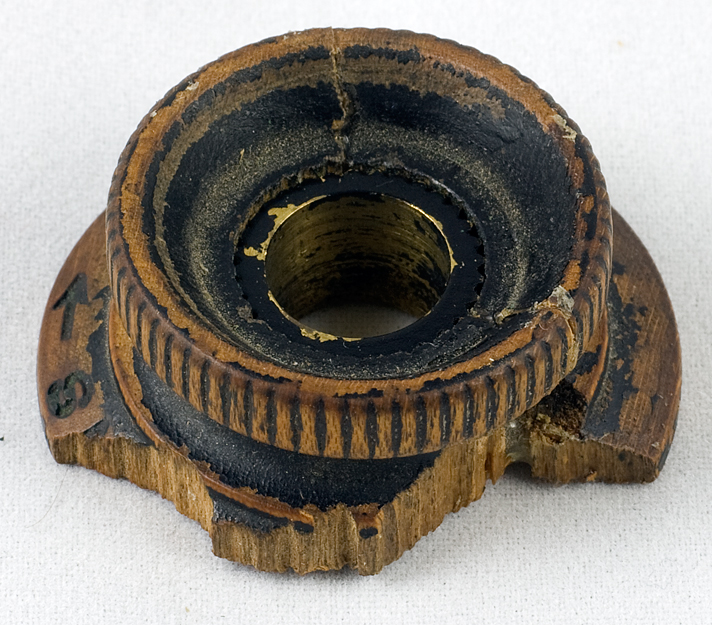
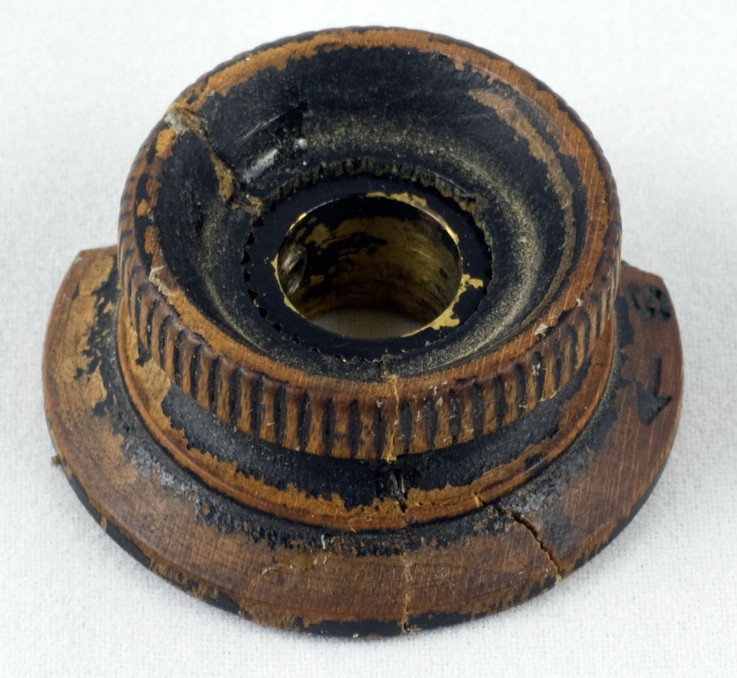
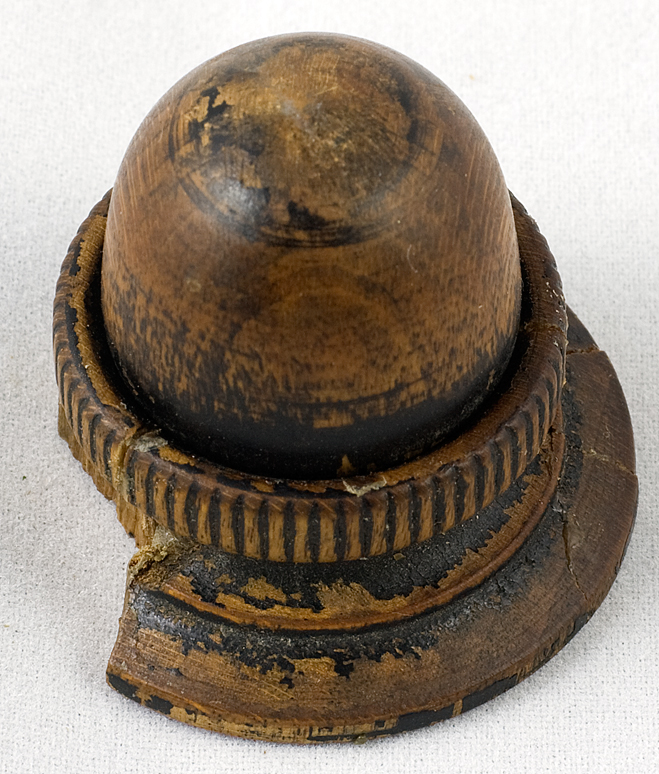
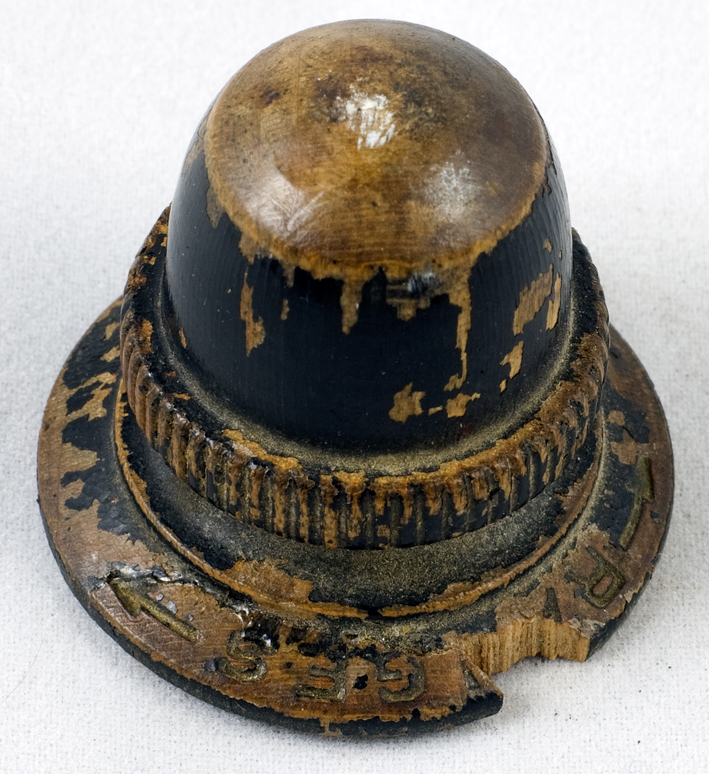
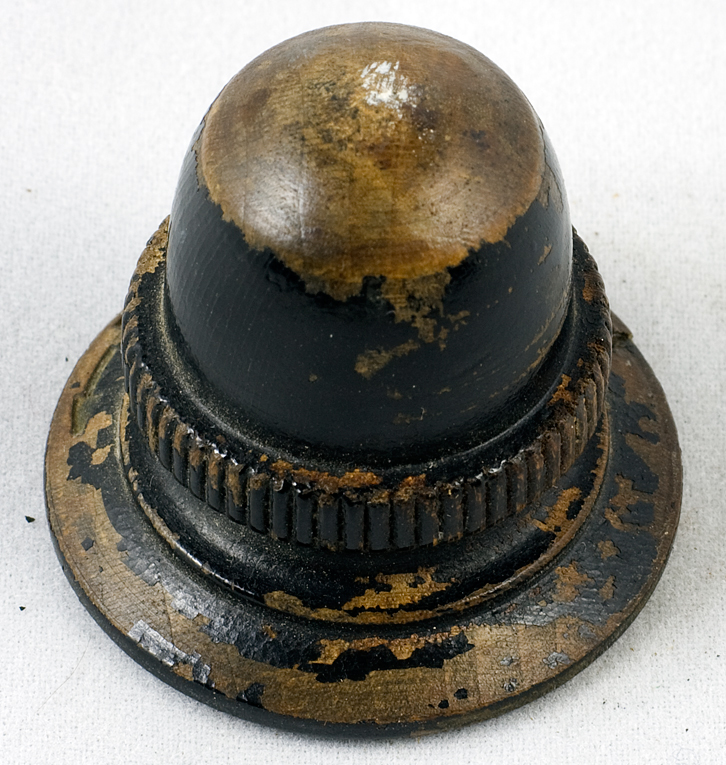
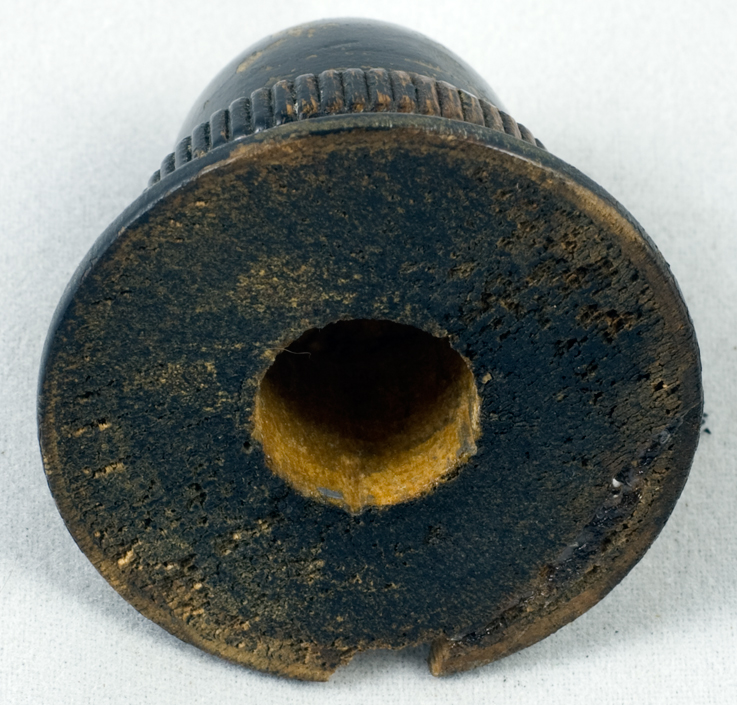
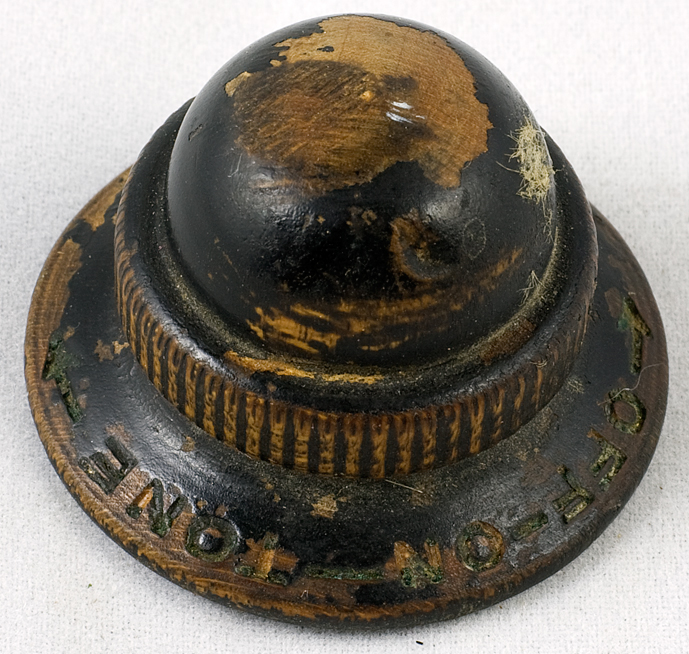
Click on photos for larger images. From left to right: 1 volume, 2 and 3 are the coarse tuning knob (different sides), 4 is the same tuning knob with the fine tuning cap on top, 5 and 6 are the bands, 7 is the band knob from underneath (all of them except the coarse tuning look like this), and 8 is the On/Off and Tone switch.
The coarse tuning knob is different in that it has a metal collar inside and a set screw. All the other have gnurled round holes and a metal adapter (not shown) that pushes in, and the metal adapter pushes onto control shaft.
These are all in various conditions as you can see. The power/tone and the volume knobs are pretty intact; the range is disintegrating a little; the coarse tuning actually broke into three big pieces that I have, plus some others that are long gone. As this gets the most use, it's probably the one that has the hardest life. I glued the pieces back and it's strong enough to go back on the shaft and be used, provided you're fairly careful with it.
They appear to have been painted black at one time and the paint is maybe 50% gone. Whether it came that way from the factory or an owner painted them afterward, I don't know. I'm debating about whether to try and paint them again. If I do paint them, I may try to fill in the smaller missing bits with putty. The tuner is missing too much so I'll probably just leave it that way.
I can't and won't complain about the condition of the knobs--I'm happy I have them all and mostly intact. Other, similar Stromberg's I've seen on the net are missing knobs or are broken, or both.
Current status: this radio is no longer in my collection. This page will be removed in late 2024.
.jpg)

 In the original advertising, they called this the "Treasure Box." Right now it looks like a treasure box that was buried by pirates and recently unearthed. The cabinet is pretty rough. There's a big pock mark on the far right facia; there are some gouches and deep scratches here and there. There's a missing piece in the bottom left corner that will have to be replaced. Elsewhere (particularly the top), the veneer is breaking off. I'm not much at wood work so I'm either going to have to learn or farm the work out to someone.
In the original advertising, they called this the "Treasure Box." Right now it looks like a treasure box that was buried by pirates and recently unearthed. The cabinet is pretty rough. There's a big pock mark on the far right facia; there are some gouches and deep scratches here and there. There's a missing piece in the bottom left corner that will have to be replaced. Elsewhere (particularly the top), the veneer is breaking off. I'm not much at wood work so I'm either going to have to learn or farm the work out to someone.










.jpg)